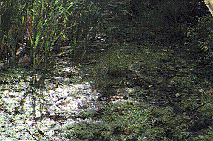1 The Pond
Depending on the time of season, this pond may or may
not
be filled with water. Over the past year it has been observed
that:
this pond is dry in the summer, wet in the fall, frozen in the winter
and
wet in the spring. This happens to be a property of a vernal
pool.
The question as to whether or not the Sanborn wetland is a vernal pool
will
be addressed later on.
If closely examined it can be seen that plant life
is making
an assault upon this pond. Its circumference is shrinking because
it
is becoming filled with plants and vegetable matter, which also results
in
oxygen deficiency in the midsummer, when it’s dry. This is called
eutrophication.
In the fall of 1998 I conducted studies on the
microorganisms in the Sanborn Wetland and used water collected from
this particular pond to collect my data. I found some interesting
stuff: amoeba, algae, flagellates
and a water flea. Microorganisms have adapted to survive the
changing
environment of the wetlands by several means. An adaptation is a
trait
selected by evolutionary processes that aids in an organism’s
survival.
Ways in which microorganisms have adapted to survive the dry summers
are
through: laying special winter eggs, entering a state of dormancy or
suspended
animation and forming a cyst, which is a sort of thick skin.
Further research can be done on the microorganisms in
our wetlands. I only found the several types that I mentioned but
there is sure to be a larger variety out there. It would be quite
a project to see how many different microorganisms exist in the Sanborn
wetland. Another interesting project would be explaining another
observation I made. In the late fall, early summer of 1998 when I
was conducting my studies and
the wetland was dry, I could find no microorganisms. Then one day
it
rained and I found a plethora. Exactly why this was I do not know.


